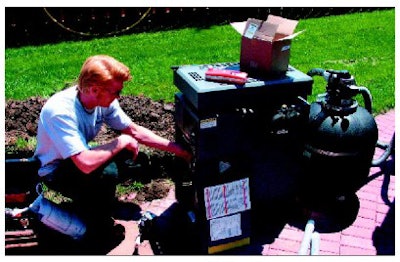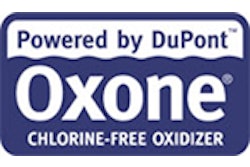
Once a luxury item installed mostly on higher-end projects, pool heaters are now becoming almost as standard as pumps and filters. More and more pool owners want a heater because it extends the season, allowing them to get the most out of their investment. In addition, each year more in-ground pools are built with spas, which definitely need heaters.
So it's no wonder the majority of pool owners today insist on having a heater. Your job, then, is to properly install an appropriate unit. To do so, installers need to consider a few factors, including the size of the gas line, the size of the gas meter, the location of the heater.
The Right Appliance
Before picking out PVC, the first thing you need to figure out is what model heater should be installed. After finding out what your client's heating needs are, you'll have to look no further than your equipment supplier.
"All the manufacturers have sizing charts and guides to help contractors select the right size appliance for what the pool owner wants the heater to do," says Peter Owenson, product manager for heaters and water features at Jandy (Water Pik Technologies). "The key point with heaters in terms of sizing the appliance is that bigger is better. There's no harm in having a heater that's bigger than the charts tell you. In the long run, it's actually a little more efficient to do it that way.
"The time it takes from when you start the heater to when you get to the desired temperature is all time during which you're also losing heat from the pool. So the longer it takes to get there, the longer you've been losing heat before you get to the temperature you want. If you can get there quickly, you've actually reached your goal and reduced that loss period. For that reason alone, bigger really is better in terms of heating your pool."
Beyond the size of the heater, the availability of fuel must also be considered when choosing an appliance. "In certain areas of the country, there's only propane," says Bill Aurther, project manager, sales and marketing for Pentair Pool Products. "But most areas of the country are natural gas. So when you figure out the size you need, you figure out which type of fuel it'll burn and then you've selected the two major points of a heater."
Aurther notes that the heater's level of sophistication should also be discussed. "Do you want to give them the fancy digitals and all the bells and whistles you can get. Or do you just want a millivolt heater." And if the pool has been or will be built with a control system, you want to be sure the heater is compatible with automation.
Is There Enough Juice?
After specifying a heater, you'll want to make sure the home has enough gas to supply both the pool heater and the household appliances.
"There may be a supply meter that's rated for 500,000 Btus," says Owenson, "but if the home is consuming 200,000 Btus, then you're limited to the 300,000 that are left.
So even though you may look at the meter, see 500,000 and think, 'I can put a 400,000-Btu heater on there,' you have to be aware of what else that meter might be supplying."
If the meter doesn't offer sufficient capacity, you need to have the homeowner upgrade the meter. Even if this issue hasn't cropped up for you yet, it may in the near future. According to Owenson, "It's become more of an issue in the last year than I've faced in the prior 10."
After determining whether the meter is adequate or needs to be upgraded, you'll need to decide where to connect the heater to the meter. "We try to go directly to the gas meter when we're hooking up our gas lines," says Mark Heusinger, service manager for Beauty Pools in Lancaster, N.Y. "We want to go to the gas meter because it's the best place to hook-up gas. Some people tie into the piping in the backyard, but we'd rather trench around the side of the house and go to the meter. It's more of a proper way to do it."
Get Gas Lines In Line
Now that you know what size heater will be used and that the meter can supply it with enough gas, you'll need to install the right size gas line. The key is to install a big enough line. "Too small of a gas pipe running too far does not deliver enough Btus," says Tim Ruesch, product manager for Sta-Rite. "A standard heater in the market is a 400,000Btu unit and on average it's anywhere between 50 and 100 feet away from the gas source. For a 400,000Btu unit up to 100 feet away from the meter, you need an inch-and-a-quarter line minimum."
Aurther says an inappropriately sized gas line accounts for a lot of the heater installation problems he sees. Because if there's not enough gas getting to the heater, "the heater will flame out."
"A 400,000-Btu heater requires 390 cubic feet of gas per hour," says Aurther, "and so if your piping between the gas meter and the heater will only carry 100 cubic feet an hour, you're not going to turn it on."
Luckily, you don't have to be an engineer to figure out what size gas line to install. "Manufacturers have also put together easy-to-use charts for this," says Owenson. "So whether it's 150 or 200 feet from the meter to the heater, the charts will tell you what size gas line you'll need, depending on the particular appliance."
The size of the gas line also comes into play when installers have to replace an existing heater. "A lot of people call me up and ask me to sell them a 400,000-Btu heater," says Heusinger, "but I can't just do that. I could, but it wouldn't be right.
"In those cases, you have to actually go out to the pool and look at what's there because it might not work. If there isn't the right size gas piping feeding it, that heater will be worthless to them."
Heusinger will install a larger heater if the gas line is big enough or if the customer is willing to pay for necessary adjustments. "I've ended up changing the whole gas line so we can put in a bigger heater. In that case, we're going to run a whole new gas line from the meter and do it right, instead of using the gas line they have."
Customers wanting a heater that may be too big for their current system is, unfortunately, an issue that won't go away any time soon. "Particularly where there is a pool and spa combination, pool owners have the expectation that if they can heat up their spa in 20 minutes, why would they want an appliance that is going to cause them to wait for an hour?" says Owenson. "They want the one that only takes 20 minutes."
Location
Yet another consideration when installing a heater is location. "Clearances around the heater are important," says Owenson. "The appliances need fresh air to keep them cool and they need the air for the combustion process going on. So having them backed into little corners where they can't get adequate air can create service issues in time, and sometimes that's a very short time.
"Also, make sure the heater is not located next to a window, door or opening that goes into a building where its exhaust gases can be diverted in there, because that will displace the oxygen in the room."
Keep in mind that what constitutes an opening into a building may not always be obvious. "The National Fuel Gas Code says any door, window or gravity inlet," Owenson notes. "So up in the eaves by the roof line, if there's ventilation holes for the attic, that constitutes an opening into that building and flue gases can be diverted in there because they're actually being trapped by the eaves and then that flue gas will fill the attic. If then dad goes up to the attic to change a light bulb, that would not be a good thing."
If indeed the heater is near eaves and roof lines, water is also a concern. "If you put them in an area where they're going to get a lot of runoff from the roof, then you want to put a rain gutter system on so that the water flow is not going directly into the heater," says Aurther. "The other thing is if you're in very windy conditions, you might want to protect the heater with fencing or some other method. Maybe put an outdoor vent kit on the heater to protect it."
If you're installing the heater indoors, "be sure to follow the manufacturer's recommendations so you get flue products properly exhausted through the proper duct work and make sure the room has adequate ventilation," says Aurther. "All the manufacturers recommend two openings to the room: one at the ceiling for ventilation and one at floor level for combustion air."
The size of these openings will vary. Says Owenson: "If those openings are covered with louvers, you have to increase them by a certain percent. If there's a screen, you have to increase them by a different percent."
Getting Along
Since heaters will always be sharing space on the pad with a pump, you'll want to consider that relationship when installing the heater. Ruesch recommends installing a manual bypass valve if the flow is going to be 100 gallons per minute or greater. "With all the water features and solar collectors, etc., today, a lot of pools have pumps that supply 100-plus gallons per minute," says Ruesch. "No. 1, you don't need all that water going away from the pool to the heater because you're not heating it up any faster. Higher flow does not equate to faster heat-up time. And No. 2, high flow will damage the exchanger. It'll cause premature erosion. So for pools that have high flow, we recommend putting in a manual bypass to divert the water away from the heater and back to the pool."
If there's a two-speed pump for the pool, make sure homeowners know to use the high speed when running their heater, because "you can't fire a 400,000 heater with a pump running on low speed," says Aurther.
If there's an in-line chlorinator at the pad, "put in a chemical-resistant check valve in between the unit and the heater to prevent any chlorine backup," says Ruesch. "What will happen is the pump will shut off and you'll get a little bit of a back siphon and that high concentration of chlorine will eat away the copper of the exchanger."
And even though others may endorse putting chlorine tablets in skimmers, Ruesch recommends using a floating chemical feeder or an in-line chlorinator. "The problem, once again, is you'll get a high buildup of chlorine when the pump is not running. So then as soon as the pump kicks on, it flushes that high amount of chlorine through the system. That's not good for the pump or the heater."
What is good for builders and service techs today is that more homeowners are willing to pay for the luxury of a warm pool on a cool day. So smart installers are sure to make a nice profit — as long as they've followed all the right steps when installing that heater.
The National Fuel Gas Code
Though all manufacturers supply information regarding what size gas pipe needs to be installed with each one of their heaters, as well as information on clearances and other location concerns, having a copy of the National Fuel Gas Code is also a good idea for anyone who installs heaters regularly.
"The National Fuel Gas Code handbook is sort of the bible for gas appliance installations," says Peter Owenson, product manager for heaters and water features at Jandy. "The National Fuel Gas Code gives such detail that even though an installation manual may require 18 inches of clearance, the National Fuel Gas Code says: If you take certain steps, then you may reduce an 18-inch requirement to 6 inches. And that could be by changing the construction of the wall behind the appliance, putting in some kind of insulation barrier, things of that nature that allow a contractor to install a heater outside of the installation manual itself, but still within the code. So having that book as a reference if you do a lot of work in a community where there are no clearances is nice because then you have that to show an inspector at any time, and say, 'Well, according to the National Fuel Gas Code, it's correct.' Having the handbook can prevent heartache with respect to getting approvals."
You can order a copy of the National Fuel Gas Code by calling the American Gas Association publication distribution center at 866/816-9444 or order online (aga.org) through the AGA's Marketplace.
—K.E.











































